
The Indo-Pakistani war of 1947–1948, also known as the first Kashmir war, was a war fought between India and Pakistan over the princely state of Jammu and Kashmir from 1947 to 1948. It was the first of four Indo-Pakistani wars between the two newly independent nations. Pakistan precipitated the war a few weeks after its independence by launching tribal lashkar (militias) from Waziristan, in an effort to capture Kashmir and to preempt the possibility of its ruler joining India.

Major-General Sir Robert Bellew Adams was a Scottish general of the Indian Army and recipient of the Victoria Cross, the highest and most prestigious award for gallantry in the face of the enemy that can be awarded to British and Commonwealth forces.

The North-West Frontier was a region of the British Indian Empire. It remains the western frontier of present-day Pakistan, extending from the Pamir Knot in the north to the Koh-i-Malik Siah in the west, and separating the modern Pakistani frontier regions of North-West Frontier Province, Federally Administered Tribal Areas and Balochistan from neighbouring Afghanistan in the west. The borderline between is officially known as the Durand Line and divides Pashtun inhabitants of these provinces from Pashtuns in eastern Afghanistan.
Dargai is one of the tehsils of Malakand District in Pakistan's northwestern Khyber Pakhtunkhwa province. It located on the main highway from Peshawar to Swat, Dir and Chitral.

The Malakand Pass is a mountain pass in the Malakand District of Khyber Pakhtunkhwa that connects Peshawar with the Chitral District.

The Tirah campaign, often referred to in contemporary British accounts as the Tirah expedition, was an Indian frontier campaign from September 1897 to April 1898. Tirah is a mountainous tract of country in what was formerly known as Federally Administered Tribal Areas of Pakistan, now Khyber Pakhtunkhwa province.

Ghazi Khan Umra Khan of Jandol, also called "The Afghan Napoleon", was a Pashtun chief on the north-western frontier of British India, who was chiefly responsible for the Chitral Expedition of 1895. He was the Khan of Jandol and captured the state of Dir and reigned as its Nawab from 1890 to 1895. Umra briefly occupied Swat, Chitral and Bajaur. He also took over Kunar and Kafiristan regions of Afghanistan.
Chakdara (چکدرہ) is a city in the Lower Dir District of Khyber Pakhtunkhwa, Pakistan. It is the second largest city in Dir Lower after Timergara. It serves as a gateway of Malakand Division. It is located in the center of Malakand Division at the entrance of the Lower Dir District, also near the entrance of the Swat District. The Swat Expressway's Chakdara interchange touches this area. Chakdara is about 130 km far from Peshawar, 40km from Mingora and 38 km from Timergara.
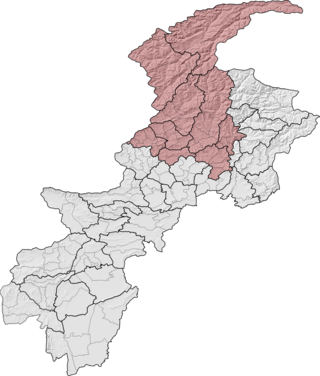
Malakand Division is an administrative division of Khyber Pakhtunkhwa province of Pakistan. Malakand is the second-largest division by population while Mingora, its capital, is the third largest city in the province. CNIC code of Malakand Division is 15.

Dir was a princely state in a subsidiary alliance with the British Raj, located within the North-West Frontier Province. Following the Partition of British India, Dir remained independent and unaligned until February 1948, when the Dominion of Pakistan accepted its accession.
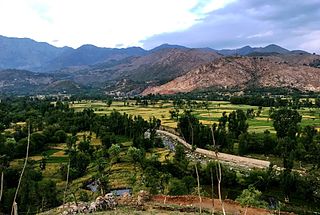
Bajaur District, formerly Bajaur Agency, is a district in the Malakand Division of Khyber Pakhtunkhwa Province, Pakistan. Prior to 2018, Bajaur Agency was the northernmost component of the Federally Administered Tribal Areas (FATA), a semi-autonomous region along the Afghanistan–Pakistan border. In May 2018, FATA was merged into the larger Khyber Pakhtunkhwa Province (KPK) in an attempt to bring stability to the region, redesignating Bajaur Agency to Bajaur District.
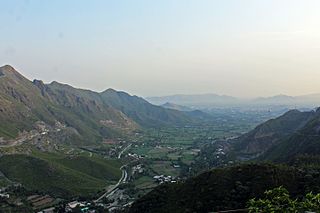
Malakand District is a district in the Malakand Division of the Khyber Pakhtunkhwa province of Pakistan.
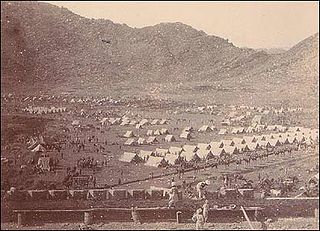
The siege of Malakand was the 26 July – 2 August 1897 siege of the British garrison in the Malakand region of colonial British India's North West Frontier Province. The British faced a force of Pashtun tribesmen whose tribal lands had been bisected by the Durand Line, the 1,519 mile (2,445 km) border between Afghanistan and British India drawn up at the end of the Anglo-Afghan wars to help hold back what the British feared to be the Russian Empire's spread of influence towards the Indian subcontinent.

General Sir Bindon Blood, was a British Army commander who served in Egypt, Afghanistan, India, and South Africa.
The First Mohmand campaign was a British military campaign against the Pashtun Mohmand tribe from 1897 to 1898.
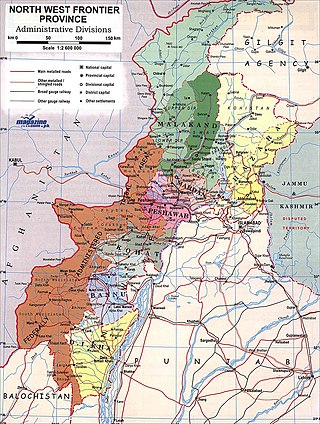
The Malakand Agency was one of the agencies in the North West Frontier Province of British India and later of Pakistan until 2010. It included the princely states of Chitral, Dir and Swat, and an area around the Malakand Pass known as the Malakand Protected Area. The largest city in the area was Mingora, while the three state capitals were Chitral, Dir, and Saidu Sharif. In 1970, following the abolition of the princely states, the agency became the Malakand Division, which was divided into districts, one of which was the Malakand Protected Area, known as Malakand District. In 2000 the Malakand Division was abolished. Despite the constitutional changes since 1970, the expression Malakand Agency is still used, sometimes of the entire area of the former Agency, but more often of Malakand District.

The Chitral Expedition was a military expedition in 1895 sent by the British authorities to relieve the fort at Chitral, which was under siege after a local coup following the death of the old ruler. An intervening British force of about 400 men was besieged in the fort until it was relieved by two expeditions, a small one from Gilgit and a larger one from Peshawar.

Sir Shuja ul-Mulk KCIE was the Ruler of the State of Chitral, and reigned it for 41 years until his death in 1936. He belonged to the royal Katur dynasty, which ruled the state from 1571 to 1969, until the Princely State of Chitral was merged to form the Chitral District of the Provincially Administered Tribal Areas, Malakand Division, North West Frontier Province, Pakistan.
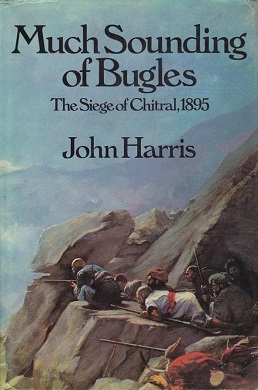
Much Sounding of Bugles: The Siege of Chitral 1895 is a book written by John Harris and originally published by Hutchinson & Co. Publishers Ltd. at London in 1975. The book presents a vivid chronicle of the Chitral Campaign and the heroic efforts of the British Indian Army in 1895. It narrates how Queen Victoria rules over nearly a quarter of the Earth's land surface, with the brightest jewel in her crown being India. Yet the might of the Raj is not to go unchallenged in the high mountains of the Hindu Kush. The State of Chitral which had till then existed as a buffer between British and Russian spheres of influence and tilted towards the Government of India in the second half of the 19th century, with the death of the Mehtar of Chitral in 1892 descends into civil war. A small British force led by Surgeon-Major George Scott Robertson is caught up in the Fort at Chitral which was to come under siege for seven weeks while a relief force was organised. The book narrates the follies of a vanished age.

The Battle of Chakdara was a battle and siege of a British military fort by rebel Pashtun tribesmen during the Siege of Malakand in colonial British India's North West Frontier Province in 1897. Due to the defensive nature of the battle, the event draws parallels with the Battle of Rorke's Drift during the Anglo-Zulu War.
















